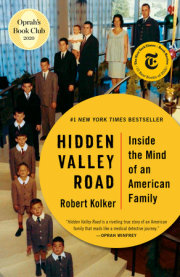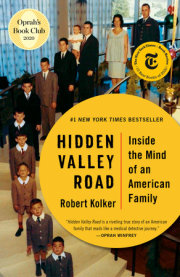Prologue1972 | Colorado Springs, ColoradoA brother and sister walk out of their house together, through the patio door that opens out from the family kitchen and into their backyard. They’re a strange pair. Donald Galvin is twenty-seven years old with deep-set eyes, his head shaved completely bald, his chin showing off the beginnings of a biblically scruffy beard. Mary Galvin is seven, half his height, with white-blond hair and a button nose.
The Galvin family lives in the Woodmen Valley, an expanse of forest and farmland nestled between the steep hills and sandstone mesas of central Colorado. Their yard smells of sweet pine, fresh and earthy. Near the patio, juncos and blue jays dart around a rock garden where the family’s pet, a goshawk named Atholl, stands guard in a mews their father built years ago. With the little girl leading the way, the sister and brother pass by the mews and climb up a small hill, stepping over lichen-covered rocks they both know by heart.
There are ten children between Mary and Donald in age—twelve Galvin kids in all; enough, their father enjoys joking, for a football team. The others have found excuses to be as far from Donald as possible. Those not old enough to have moved away are playing hockey or soccer or baseball. Mary’s sister, Margaret—the only other girl, and the sibling closest to Mary in age—might be with the Skarke girls next door, or down the road at the Shoptaughs’. But Mary, still in second grade, often has nowhere to go after school but home, and no one to look after her but Donald.
Everything about Donald confounds Mary, starting with his shaved head and continuing with what he likes most to wear: a reddish brown bedsheet, worn in the style of a monk. Sometimes he completes the outfit with a plastic bow and arrow that his little brothers once played with. In any weather, Donald walks the neighborhood dressed this way, mile after mile, all day and into the night—down their street, the unpaved Hidden Valley Road, past the convent and the dairy farm in the Woodmen Valley, along the shoulders and onto the median strips of highways. He often stops at the grounds of the United States Air Force Academy, where their father once worked, and where many people now pretend not to recognize him. And closer to home, Donald has stood sentry as children play in the yard of the local elementary school, announcing in his soft, almost Irish lilt that he is their new teacher. He only stops when the principal demands that he stay away. In those moments, Mary, a second-grader, is sorrier than ever that her world is so small that everyone knows that she is Donald’s sister.
Mary’s mother is well practiced at laughing off moments like these, behaving as if nothing is strange. To do anything else would be the same as admitting that she lacks any real control over the situation—that she cannot understand what is happening in her house, much less know how to stop it. Mary, in turn, has no choice but to not react at all to Donald. She notices how closely both her mother and father monitor all of their children now for warning signs: Peter with his rebellion, Brian and his drugs, Richard getting expelled, Jim picking fights, Michael checking out completely. To complain or cry or show any emotion at all, Mary knows, will send the message that something might be wrong with her, too.
And the fact is that the days when Mary sees Donald in that bedsheet are better than some of the other days. Sometimes after school, she comes home to find Donald in the middle of an undertaking only he can understand—like transplanting every last piece of furniture out of the house and into the backyard, or pouring salt into the aquarium and poisoning all the fish. Other times, he is in the bathroom, vomiting his medications: Stelazine and Thorazine and Haldol and Prolixin and Artane. Sometimes he is sitting in the middle of the living room quietly, completely naked. Sometimes the police are there, summoned by their mother, after hostilities have broken out between Donald and one or more of his brothers.
But most of the time, Donald is consumed by religious matters. Explaining that Saint Ignatius conferred upon him a degree in “spiritual exercise and theology,” he spends much of every day and many nights reciting in full voice the Apostles’ Creed and the Lord’s Prayer and a list of his own devising that he calls Holy Order of Priests, the logic of which is known only to him.
D.O.M., Benedictine, Jesuit, Order of the Sacred Heart, Immaculate Conception, Mary, Immaculate Mary, Oblate Order of Priests, May Family, Black Friar, The Holy Ghost, Franciscan at the Convent, One Holy Universal, Apostolic, Trappist . . .For Mary, the prayers are like a faucet that won’t stop dripping. “Stop it!” she shrieks, and yet Donald never does, pausing barely long enough to breathe. She sees what he’s doing as a rebuke of her entire family, but mostly of their father, a faithful Catholic. Mary idolizes her father. So does every other Galvin child—even Donald did, before he got sick. When Mary sees her father coming and going from the house whenever he likes, she is envious. She thinks about the sense of control that her father must enjoy by working so hard all the time. Hard enough to get out.
It is the way her brother singles Mary out that she finds most unbearable—not because he is cruel but because he is kind, even tender. Her full name is Mary Christine, and so Donald has decided that she is Mary, the sacred virgin and mother of Christ. “I
am not!” Mary cries, again and again. She believes that she is being teased. It would not be the first time that one of her brothers has tried to make a fool of her. But Donald is so unmistakably serious—so fervent, so reverential—it only makes Mary angrier. He has made Mary the exalted object of his prayers—bringing her into his world, which is the last place that she would ever want to be. The idea that Mary comes up with, the solution to the problem of Donald, is a direct response to the rage she feels. Her inspiration comes from the sword- and- sandals epics that her mother sometimes watches on television.
The idea starts with her saying, “Let’s go up to the hill.” Donald consents; anything for the sacred virgin. It continues with Mary suggesting that they build a swing on a tree branch. “Let’s bring a rope,” she says. Donald does as she says. And it concludes at the top of the hill, where Mary selects a tree, one of many tall pines, and tells Donald that she’d like to tie him to it. Donald says yes. And hands her the rope.
Even if Mary were to reveal her plan to Donald—to burn him at the stake, like the heretics in the movies—it is doubtful that he would react. He is too busy praying. He stands tightly against the tree trunk, lost in his own stream of words as Mary walks around the tree with the rope, circling and pulling until she believes he cannot break free. Donald does not resist.
She tells herself that no one will miss him when he’s gone—and that no one will ever suspect her. She goes searching for kindling and brings back armfuls of twigs and branches, dropping them at his bare feet.
Donald is ready. If Mary really is who he insists she is, he can hardly say no. He is calm, patient, kind.
He adores her.
But on this day, Mary is serious only to a point. She has no matches, no way to make a fire. More crucially, she is not like her brother. She is grounded, her mind rooted in the real world. If nothing else, Mary is determined to prove that, not just to her mother, but to herself.
So she abandons her plan. She strands Donald on the hill. He stays up there, surrounded by flies and pasqueflowers, standing in place and praying for a very long time. Long enough that Mary gets some time to herself, but not so long that he doesn’t come back down again.
*
She manages a smile now when she thinks about it. “Margaret and I laugh,” she says. “I’m not sure others would find it quite so funny.”
On a crisp winter afternoon in 2017—forty-five years, a lifetime, after that day on the hill—the woman once known as Mary Galvin pulls her SUV into a parking space at Point of the Pines, an assisted living facility in Colorado Springs, and walks inside to see the brother she once fantasized about burning alive. She is in her fifties now, with the same bright eyes, though in her adulthood she has chosen to go by a different first name: Lindsay, a name she picked as soon as she left home—a determined young girl’s attempt to make a break with the past and become someone new.
Lindsay lives a six-hour drive away, just outside Telluride, Colorado. She owns her own business, staging corporate events—working as hard as her father ever did, crisscrossing the state between home and Denver, where most of her events take place, and Colorado Springs, where she can tend to Donald and others in her family. Her husband, Rick, runs instructor training for the Telluride ski school, and they have two teenagers, one in high school and one in college. Anyone who meets Lindsay now usually doesn’t see past her calm confidence, her easy smile. After years of practice, she has an artful way of pretending as if everything is completely normal, even when the case is quite the opposite. Only a tart, razor-sharp comment now and then suggests something else—something melancholic and immutable, simmering beneath the surface.
Donald is waiting for her in the first-floor lounge. Dressed casually in a wrinkled, untucked Oxford shirt and long cargo shorts, her oldest brother, in his seventies now, looks incongruously distinguished, with wisps of white hair at his temples, a cleft chin, and heavy black eyebrows. He could be cast in a gangster movie, if his voice weren’t so gentle and his gait so stiff. “He has a little bit of that Thorazine shuffle still left, the way he walks,” says Kriss Prado, a manager at the facility. Donald takes clozapine now, a sort of last-resort psychotropic drug with both a high rate of effectiveness and a high risk of extreme side effects—heart inflammation, low white blood cell count, even seizures. One of the consequences of surviving schizophrenia for fifty years is that sooner or later, the cure becomes as damaging as the disease.
When Donald spots his sister, he stands up, ready to leave. Usually, when Lindsay visits, it’s to take him out to see other family. Smiling warmly, Lindsay says they’re not going anywhere today—that she is there to see how he is doing and to talk with his doctors. Donald smiles, too, slightly, and sits back down. No one in his family comes to see him there but her.
Lindsay has had decades to make sense of her childhood, and in many ways that project continues. So far, she has learned that the key to understanding schizophrenia is that, despite a century of research, such a key remains elusive. There is a menu of symptoms, various ways the illness presents: hallucinations, delusions, voices, comalike stupors. There are specific tells, too, like the inability to grasp the most basic figures of speech. Psychiatrists speak of “loosening of associations” and “disorganized thinking.” But it is hard for anyone to explain to Lindsay why, on a day like today, Donald is cheerful, even content, while on another day he is frustrated, demanding she drive him to the state mental hospital in Pueblo, where he has been admitted more than a dozen times over fifty years, and where he often says that he would like to live. She can only guess why, when Donald is brought to the supermarket, he always buys two bottles of All clothing detergent, announcing brightly, “This is the best body wash ever!” Or why, almost fifty years later, he still recites that religious litany:
Benedictine, Jesuit, Order of the Sacred Heart. . . . Or why, for almost as long, Donald has consistently and unwaveringly maintained that he is, in fact, the offspring of an octopus.
The most dreadful thing, perhaps, about schizophrenia—and what most sets it apart from other brain conditions like autism or Alzheimer’s, which tend to dilute and dissipate a person’s most identifiable personality traits—is how baldly emotional it can be. The symptoms muffle nothing and amplify everything. They’re deafening, overpowering for the subject and frightening for those who love them—impossible for anyone close to them to process intellectually. For a family, schizophrenia is, primarily, a felt experience, as if the foundation of the family is permanently tilted in the direction of the sick family member. Even if just one child has schizophrenia, everything about the internal logic of that family changes.
But the Galvins never were an ordinary family. In the years when Donald was the first, most conspicuous case, five other Galvin brothers were quietly breaking down.
There was Peter, the youngest boy and the family rebel, who was manic and violent, and who for years refused all help.
And Matthew, a talented ceramic artist, who, when he wasn’t convinced that he was Paul McCartney, believed that his moods controlled the weather.
And Joseph, the most mild-mannered and poignantly self-aware of the sick boys, who heard voices, as real to him as life itself, from a different time and place.
And Jim, the maverick second son, who feuded viciously with Donald and went on to victimize the most defenseless members of his family—most notably the girls, Mary and Margaret.
And, finally, Brian, perfect Brian, the family’s rock star, who kept his deepest fears a secret from them all—and who, in one inscrutable flourish of violence, would change all of their lives forever.
*
The dozen children in the Galvin family perfectly spanned the baby boom. Donald was born in 1945, Mary in 1965. Their century was the American century. Their parents, Mimi and Don, were born just after the Great War, met during the Great Depression, married during World War II, and raised their children during the Cold War. In the best of times, Mimi and Don seemed to embody everything that was great and good about their generation: a sense of adventure, industriousness, responsibility, and optimism (anyone who has twelve children, the last several against the advice of doctors, is nothing if not an optimist). As their family grew, they witnessed entire cultural movements come and go. And then all the Galvins made their own contribution to the culture, as a monumental case study in humanity’s most perplexing disease.
Six of the Galvin boys took ill at a time when so little was understood about schizophrenia—and so many different theories were colliding with one another—that the search for an explanation overshadowed everything about their lives. They lived through the eras of institutionalization and shock therapy, the debates between psychotherapy versus medication, the needle-in-a-haystack search for genetic markers for the disease, and the profound disagreements about the cause and origin of the illness itself. There was nothing generic about how they each experienced the illness: Donald, Jim, Brian, Joseph, Matthew, and Peter each suffered differently, requiring differing treatments and a panoply of shifting diagnoses, and prompting conflicting theories about the nature of schizophrenia. Some of those theories could be especially cruel to the parents, who often took the blame, as if they’d caused the disease by something they did or did not do. The entire family’s struggle doubles as a thinly veiled history of the science of schizophrenia—a history that for decades took the form of a long argument over not just what caused the illness, but what it actually is.
The children who did not become mentally ill were, in many respects, as affected as their brothers. It is hard enough to individuate oneself in any family with twelve children; here was a family that was defined by dynamics like no other, where the state of being mentally ill became the norm of the household, the position from which everything else had to start. For Lindsay, her sister, Margaret, and their brothers John, Richard, Michael, and Mark, being a member of the Galvin family was about either going insane yourself or watching your family go insane—growing up in a climate of perpetual mental illness. Even if they happened not to descend into delusions or hallucinations or paranoia—if they didn’t come to believe that the house was under attack, or that the CIA was searching for them, or that the devil was under their bed—they felt as if they were carrying an unstable element inside themselves. How much longer, they wondered, before it would overtake them, too?
As the youngest, Lindsay endured some of the worst of what happened—left in harm’s way, directly hurt by people she thought loved her. When she was little, all she wanted was to be someone else. She could have left Colorado and started over, changed her name for real, assumed a new identity, and tried to scribble over the memory of all she went through. A different person would have gotten out as soon as she could and never come back.
And yet here Lindsay is at Point of the Pines, checking to see if the brother she once dreaded needs a heart examination, if he’s signed all the forms that need signing, if the doctor has seen him enough. She does the same for her other sick brothers, too, the ones still living. With Donald, for the length of her visit today, Lindsay pays careful attention as he wanders the halls. She worries that he is not taking good enough care of himself. She wants the best for him.
In spite of everything, she loves him. How did that change?
*
The odds of a family like this one existing at all, much less one that remained intact long enough to be discovered, seem impossible to calculate. The precise genetic pattern of schizophrenia has defied detection; its existence announces itself, but fleetingly, like flickering shadows on the wall of a cave. For more than a century, researchers have understood that one of the biggest risk factors for schizophrenia is heritability. The paradox is that schizophrenia does not appear to be passed directly from parent to child. Psychiatrists, neurobiologists, and geneticists all believed that a code for the condition had to be there somewhere, but have never been able to locate it. Then came the Galvins, who, by virtue of the sheer number of cases, offered a greater degree of insight into the illness’s genetic process than anyone imagined possible. Certainly no researcher had ever encountered six brothers in one family—full- blooded siblings, with the same two parents in common, the same shared genetic line.
Starting in the 1980s, the Galvin family became the subject of study by researchers on the hunt for a key to understanding schizophrenia. Their genetic material has been analyzed by the University of Colorado Health Sciences Center, the National Institute of Mental Health, and more than one major pharmaceutical company. As with all such test subjects, their participation was always confidential. But now, after nearly four decades of research, the Galvin family’s contribution finally can be seen clearly. Samples of their genetic material have formed the cornerstone of research that has helped unlock our understanding of the disease. By analyzing this family’s DNA and comparing it with genetic samples from the general population, researchers are on the cusp of making significant advances in treatment, prediction, and even prevention of schizophrenia.
Until recently, the Galvins were completely unaware of how they might be helping others—oblivious to how their situation had, among some researchers, created such a feeling of promise. But what science has learned from them is only one small portion of their story. That story begins with their parents, Mimi and Don, and a life together that took flight with limitless hope and confidence, only to curdle and collapse in tragedy, confusion, and despair.
But the story of the children—of Lindsay, her sister, and her ten brothers—was always about something different. If their childhood was a funhouse- mirror reflection of the American dream, their story is about what comes after that image is shattered.
That story is about children, now grown, investigating the mysteries of their own childhood—reconstituting the fragments of their parents’ dream, and shaping it into something new.
It is about rediscovering the humanity in their own brothers, people who most of the world had decided were all but worthless.
It is about, even after the worst has happened in virtually every imaginable way, finding a new way to understand what it means to be a family.
Copyright © 2020 by Robert Kolker. All rights reserved. No part of this excerpt may be reproduced or reprinted without permission in writing from the publisher.











